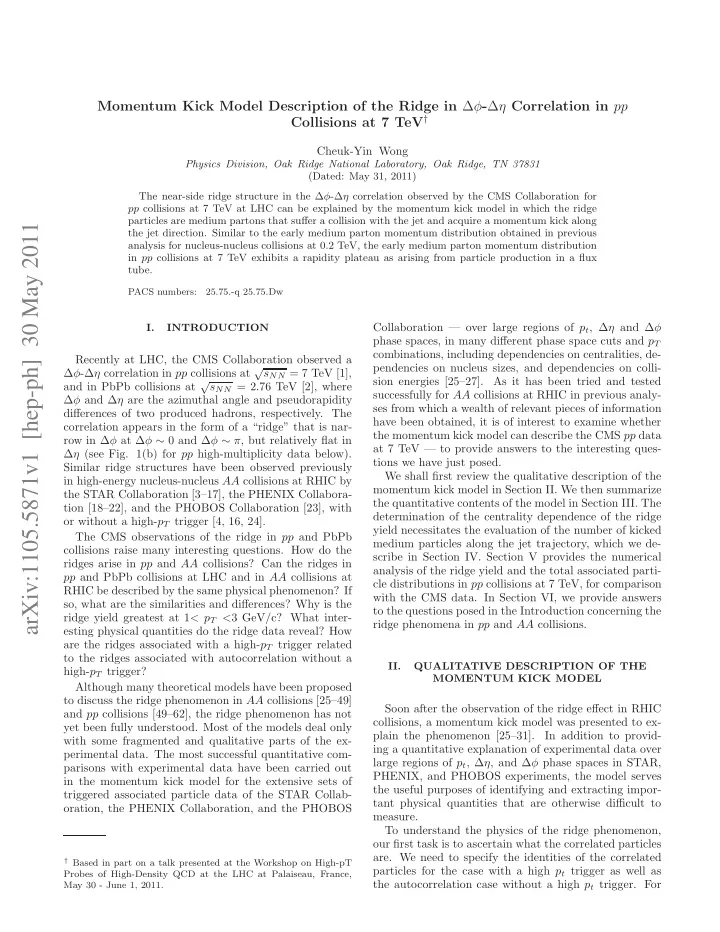

Momentum Kick Model Description of the Ridge in ∆ φ - ∆ η Correlation in pp Collisions at 7 TeV † Cheuk-Yin Wong Physics Division, Oak Ridge National Laboratory, Oak Ridge, TN 37831 (Dated: May 31, 2011) The near-side ridge structure in the ∆ φ -∆ η correlation observed by the CMS Collaboration for pp collisions at 7 TeV at LHC can be explained by the momentum kick model in which the ridge particles are medium partons that suffer a collision with the jet and acquire a momentum kick along arXiv:1105.5871v1 [hep-ph] 30 May 2011 the jet direction. Similar to the early medium parton momentum distribution obtained in previous analysis for nucleus-nucleus collisions at 0.2 TeV, the early medium parton momentum distribution in pp collisions at 7 TeV exhibits a rapidity plateau as arising from particle production in a flux tube. PACS numbers: 25.75.-q 25.75.Dw Collaboration — over large regions of p t , ∆ η and ∆ φ I. INTRODUCTION phase spaces, in many different phase space cuts and p T combinations, including dependencies on centralities, de- Recently at LHC, the CMS Collaboration observed a ∆ φ -∆ η correlation in pp collisions at √ s NN = 7 TeV [1], pendencies on nucleus sizes, and dependencies on colli- and in PbPb collisions at √ s NN = 2 . 76 TeV [2], where sion energies [25–27]. As it has been tried and tested successfully for AA collisions at RHIC in previous analy- ∆ φ and ∆ η are the azimuthal angle and pseudorapidity ses from which a wealth of relevant pieces of information differences of two produced hadrons, respectively. The have been obtained, it is of interest to examine whether correlation appears in the form of a “ridge” that is nar- the momentum kick model can describe the CMS pp data row in ∆ φ at ∆ φ ∼ 0 and ∆ φ ∼ π , but relatively flat in at 7 TeV — to provide answers to the interesting ques- ∆ η (see Fig. 1(b) for pp high-multiplicity data below). tions we have just posed. Similar ridge structures have been observed previously We shall first review the qualitative description of the in high-energy nucleus-nucleus AA collisions at RHIC by momentum kick model in Section II. We then summarize the STAR Collaboration [3–17], the PHENIX Collabora- the quantitative contents of the model in Section III. The tion [18–22], and the PHOBOS Collaboration [23], with determination of the centrality dependence of the ridge or without a high- p T trigger [4, 16, 24]. yield necessitates the evaluation of the number of kicked The CMS observations of the ridge in pp and PbPb medium particles along the jet trajectory, which we de- collisions raise many interesting questions. How do the scribe in Section IV. Section V provides the numerical ridges arise in pp and AA collisions? Can the ridges in analysis of the ridge yield and the total associated parti- pp and PbPb collisions at LHC and in AA collisions at cle distributions in pp collisions at 7 TeV, for comparison RHIC be described by the same physical phenomenon? If with the CMS data. In Section VI, we provide answers so, what are the similarities and differences? Why is the to the questions posed in the Introduction concerning the ridge yield greatest at 1 < p T < 3 GeV/c? What inter- ridge phenomena in pp and AA collisions. esting physical quantities do the ridge data reveal? How are the ridges associated with a high- p T trigger related to the ridges associated with autocorrelation without a II. QUALITATIVE DESCRIPTION OF THE high- p T trigger? MOMENTUM KICK MODEL Although many theoretical models have been proposed to discuss the ridge phenomenon in AA collisions [25–49] Soon after the observation of the ridge effect in RHIC and pp collisions [49–62], the ridge phenomenon has not collisions, a momentum kick model was presented to ex- yet been fully understood. Most of the models deal only plain the phenomenon [25–31]. In addition to provid- with some fragmented and qualitative parts of the ex- ing a quantitative explanation of experimental data over perimental data. The most successful quantitative com- large regions of p t , ∆ η , and ∆ φ phase spaces in STAR, parisons with experimental data have been carried out PHENIX, and PHOBOS experiments, the model serves in the momentum kick model for the extensive sets of the useful purposes of identifying and extracting impor- triggered associated particle data of the STAR Collab- tant physical quantities that are otherwise difficult to oration, the PHENIX Collaboration, and the PHOBOS measure. To understand the physics of the ridge phenomenon, our first task is to ascertain what the correlated particles are. We need to specify the identities of the correlated † Based in part on a talk presented at the Workshop on High-pT particles for the case with a high p t trigger as well as Probes of High-Density QCD at the LHC at Palaiseau, France, the autocorrelation case without a high p t trigger. For May 30 - June 1, 2011.
Recommend
More recommend